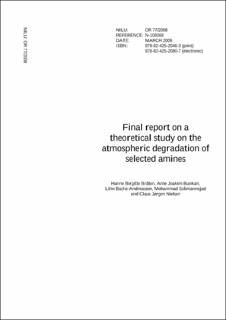Final report on a theoretical study on the atmospheric degradation of selected amines.
Bråten, Hanne Birgitte; Bunkan, Arne Joakim; Bache-Andreassen, Lihn; Solimannejad, Mohammad; Nielsen, Claus Jørgen
Abstract
Amines emitted into the atmosphere will undergo a series of chemical and physical processes. Compounds with liquid-phase vapour pressures > l0-6 Torr at the ambient atmospheric temperature will to a large extent undergo reactions in the gas phase. For the majority of gas-phase organic chemicals present in the troposphere, reaction with the OH radical is the dominant loss process. In general the degradation is initiated by reaction with OH and, where appropriate, direct photolysis and the reactions with O3 and NO3. In marine areas reactions with Cl atoms may also constitute an important sink. The types of radical generated following initiation processes include peroxy (RO2), oxy (RO) and excited and stabilized Criegee (R'R"COO) species, which each have a number of possible reactions which may be competitive under tropospheric conditions. The complex initiation and radical chemistry leads to the generation of many different products. Some are species which themselves have primary emissions, such as simple alcohols, aldehydes and ketones; others include complex (multifunctional) carbonyls, nitrates (RONO2), peroxy nitrates (RC(=O)OONO2), hydroperoxides (ROOH), percarboxylic acids (RC(=O)OOH) and carboxylic acids (RC(=O)OH). A literature survey was carried out and theoretical degradation mechanisms for selected amines have been developed on the basis of experimental findings.
